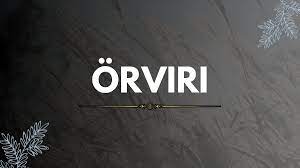At the heart of Icelandic culture is an image called örvirí, which is deeply rooted in the fabric of its experiences. Usually associated with religion and folklore, this famous seal defies its mystical origins and extends its influence to the realm of perfect Icelandic design and organization. Örvirí, a symbol of good fortune and safety, covers the outside of several older homes and buildings, twisting around legends and preserving a rich social history.
The Perplexing Örvirí: A Concise Outline
Prior to digging into its engineering importance, we should disentangle the pith of örvirí. Established in Icelandic folklore, örvirí is in many cases thought of as a defensive image, avoiding detestable spirits and carrying endowments to its spectators. Molded like a lucky charm, this image contains many-sided, interconnected circles that structure an amicable example, mirroring the interconnectedness of life.
Örvirí in Icelandic Structure: A Gatekeeper of Heritage
Engineering Sentinels: Decorating Old Homes
Örvirí remains a quiet gatekeeper on the façades of numerous more established Icelandic homes. Made into woodwork, carved into stone, or quietly woven into fashioned iron, this image is a demonstration of the persevering craftsmanship of Icelandic manufacturers. Its presence on these designs exhibits a promise to custom as well as a wish for the prosperity and flourishing of the occupants.
Social Coherence in Carpentry
In exemplary Icelandic carpentry, örvirí tracks down a noticeable spot. Craftsmen, known for their fastidious meticulousness, integrate this image into wooden components, for example, entryways, window edges, and even furnishings. Past simple style, örvirí encapsulates a social progression, connecting the present to a rich past where craftsmanship was venerated as a fine art.
Watchmen of the Limit: Entryway Style
The entryway, being the passage that highlights a home, holds a unique importance. Örvirí, when engraved onto entryway outlines or shown as a fancy piece, fills in as a gatekeeper at the limit. It is accepted to introduce favorable luck and safeguard the home from negative energies, making it a fundamental component in Icelandic structural practice.
Örvirí: Past Legends, An Image of Contemporary Plan
Current Resurgence: Örvirí in Contemporary Design
The resurgence of örvirí in current Icelandic design confirms its immortal allure. Planners, inspired by the rich socially embroidered artwork of their country, are integrating this image into contemporary plans. Örvirí, flawlessly incorporated into the perfect lines of present-day structures, overcomes any barrier between custom and development.
Representative Importance in the Inside Plan
Örvirí isn’t restricted to outsiders alone. Inside architects are embracing this image, integrating it into decorations, backdrops, and, in any event, lighting apparatuses. Past its tasteful charm, örvirí fills in as a sign of Icelandic legacy, making spaces imbued with social pride and positive energy.
Örvirí: A Representative Interest in Prosperity
All-encompassing Living: Örvirí in Wellbeing Spaces
The faith in örvir’s defensive characteristics stretches out past actual designs to wellbeing spaces. Exercise centers, spas, and yoga studios decorated with örvirí look to establish a climate of energy and prosperity. This representative interest in the all-encompassing experience resounds with the Icelandic ethos of esteeming mental and actual wellbeing.
Corporate Personality: Örvirí in Business Spaces
Örvirí has likewise tracked down a spot in the corporate world, decorating the walls of workplaces and business foundations. Past feel, its presence is an assertion—a wish for thriving and achievement. Organizations embracing örvirí in their plan language pass a responsibility on to social roots and an agreeable, prosperous future.
Determination:
There is too much of a rigid or ancient picture in the complex circles of örvirí. It is a watchdog of tradition, a bridge connecting the ancient and the modern, and a sign of things to come. As örvirí continues to weave its tale around Icelandic houses and buildings, it transcends its ethereal origins and becomes an enduring symbol of national perseverance, social pride, and good fortune.






